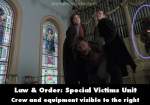Plot hole: Although William Lewis burns his fingertips in an attempt to avoid identification, the Special Victims Unit could have identified him early on by examining the remaining unburned area of Lewis' hands, and in good police procedure still record the newly scarred fingerprints, as these new scars actually make his fingerprints more unique. His scarred fingerprints would still be at Alice's apartment crime scene, and during the trial at the end of the episode the prosecution would still have a strong argument for placing Lewis at Alice's apartment, even if the DNA evidence is thrown out because of alleged cross contamination.

Law & Order: Special Victims Unit (1999)
1 plot hole in season 14
Starring: Christopher Meloni, Richard Belzer, Mariska Hargitay, Dann Florek

Visible crew/equipment: While Benson and Stabler apprehend their suspect in a church, at least one crew member appears on the right side of the frame for about 5 seconds where no one should be. (00:25:45)
Dr. Huang: I'm conflicted about labeling a ten year old a psychopath. But...
Don Cragen: "But"?
Dr. Huang: I've had a chill like that two times in my life. With death row serial killers.
Trivia: As the detectives are trying to find out from Doug Hutchinson's character where the victim is being held, the detectives find out he is somewhat claustrophobic. They decide to scare him and put him in a cupboard without any light. This is very similar to Doug Hutchinson's character in The Green Mile. The main characters decide to punish him and force him into a dark and small room.
Question: Why was A.J. only charged with reckless endangerment? The video showed him punching Paula in the back when she's climbing the stairwell, getting punched in the face by A.J. and then being dragged away unconscious. Shouldn't he have been charged with either aggravated assault or assault and battery instead considering how violent he was?
Join the mailing list
Separate from membership, this is to get updates about mistakes in recent releases. Addresses are not passed on to any third party, and are used solely for direct communication from this site. You can unsubscribe at any time.
Check out the mistake & trivia books, on Kindle and in paperback.




Answer: I didn't see the show so I don't know the details. A general answer would be because a reckless endangerment charge is easier to prove "beyond a Reasonable Doubt" in court and get a conviction. This charge would not require the prosecutor to prove intent, which would be required for proving aggravated or simple assault. Also, if there were no visible injuries, it is difficult to show bodily injury. Just because the reckless endangerment charge was specifically mentioned, it does not necessarily mean there were not other charges filed. Police often make multiple charges, like lesser-included offenses, so that the defendant's act will fall under one of them if the legal requirements are not met for the others, if they are not sure of the best charge to make (the district attorney knows and can decide), or to have something to plea bargain with.
KeyZOid